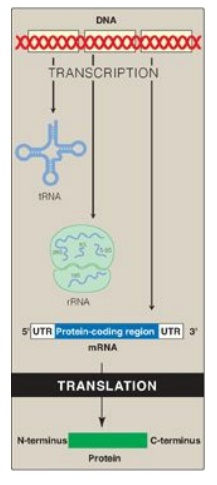Overview of Protein Synthesis
| Home | | Biochemistry |Chapter: Biochemistry : Protein Synthesis
Genetic information, stored in the chromosomes and transmitted to daughter cells through DNA replication, is expressed through transcription to RNA and, in the case of messenger RNA (mRNA), subsequent translation into proteins (polypeptide chains).
Protein Synthesis
OVERVIEW
Genetic information,
stored in the chromosomes and transmitted to daughter cells through DNA
replication, is expressed through transcription to RNA and, in the case of
messenger RNA (mRNA), subsequent translation into proteins (polypeptide chains)
as shown in Figure 31.1. The process of protein synthesis is called translation
because the “language” of the nucleotide sequence on the mRNA is translated
into the language of an amino acid sequence. Translation requires a genetic
code, through which the information contained in the nucleic acid sequence is
expressed to produce a specific sequence of amino acids. Any alteration in the
nucleic acid sequence may result in an incorrect amino acid being inserted into
the polypeptide chain, potentially causing disease or even death of the
organism. Newly made (nascent) proteins undergo a number of processes to
achieve their functional form. They must fold properly, and misfolding can
result in aggregation or degradation of the protein. Many proteins are
covalently modified to activate them or alter their activities. Finally,
proteins are targeted to their final intra- or extracellular destinations by
signals present in the proteins themselves.

Figure 31.1 Protein synthesis
or translation. tRNA = transfer RNA; rRNA = ribosomal RNA; mRNA = messenger
RNA; UTR = untranslated region.
Related Topics
